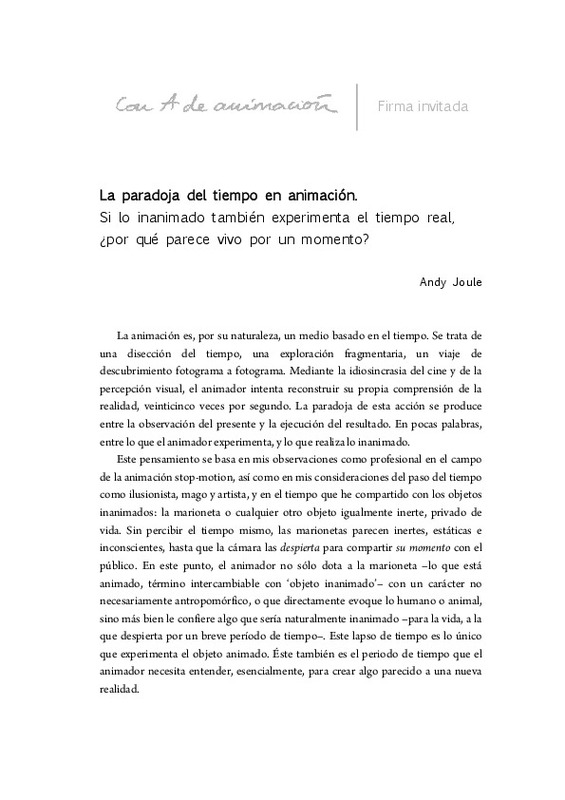JavaScript is disabled for your browser. Some features of this site may not work without it.
Buscar en RiuNet
Listar
Mi cuenta
Estadísticas
Ayuda RiuNet
Admin. UPV
La paradoja del tiempo en animación. Si lo inanimado también experimenta el tiempo real, ¿por qué parece vivo por un momento?
Mostrar el registro sencillo del ítem
Ficheros en el ítem
| dc.contributor.author | Joule, Andy
|
es_ES |
| dc.date.accessioned | 2011-09-26T12:37:28Z | |
| dc.date.available | 2011-09-26T12:37:28Z | |
| dc.date.issued | 2011 | |
| dc.identifier.issn | 2173-6049 | |
| dc.identifier.uri | http://hdl.handle.net/10251/11682 | |
| dc.description.abstract | [EN] Animation is by nature a time based medium. It is a dissection of time, a fragmentary exploration and journey of discovery frame by frame. By utilising the idiosyncrasies of film and perception of vision, the animator attempts to reconstruct their understanding of reality twenty five times every second. The paradox of this action occurs between the observation of this and the execution of the result. In short this is what the animator experiences and what the inanimate does. This extract is based on my observations as a practitioner in the field of stopmotion animation, and my considerations of the passage of time for me as the illusionist, conjurer and artist, and the time that I shared with the inanimate object. Unaware itself of time the puppets would appear lifeless, static and unconscious, until the camera awoke and shared its moment with the audience. | |
| dc.description.abstract | [ES La animación es un medio basado en el tiempo. Se trata de una disección del tiempo, una exploración fragmentaria, un viaje de descubrimiento fotograma a fotograma, donde el animador intenta reconstruir su propia comprensión de la realidad, veinticinco veces por segundo. La paradoja de esta acción se produce entre la observación del presente y la ejecución del resultado (entre lo que el animador experimenta, y lo que realiza lo inanimado). Este pensamiento se basa en mis observaciones como profesional en el campo de la animación stop-motion, así como en mis consideraciones del paso del tiempo como ilusionista, mago y artista, y en el tiempo que he compartido con los objetos inanimados: sin percibir el tiempo mismo, las marionetas parecen inertes, estáticas e inconscientes, hasta que la cámara las despierta para compartir su momento con el público. | |
| dc.language | Español | es_ES |
| dc.publisher | Editorial Universitat Politècnica de València | es_ES |
| dc.relation.ispartof | Con A de Animación | |
| dc.rights | Reserva de todos los derechos | es_ES |
| dc.subject | Tiempo | |
| dc.subject | Marioneta | |
| dc.subject | Stop-motion | |
| dc.subject | Fotogramas | |
| dc.title | La paradoja del tiempo en animación. Si lo inanimado también experimenta el tiempo real, ¿por qué parece vivo por un momento? | es_ES |
| dc.type | Artículo | es_ES |
| dc.date.updated | 2011-09-26T09:22:11Z | |
| dc.identifier.doi | 10.4995/caa.2011.860 | |
| dc.rights.accessRights | Abierto | es_ES |
| dc.description.bibliographicCitation | Joule, A. (2011). La paradoja del tiempo en animación. Si lo inanimado también experimenta el tiempo real, ¿por qué parece vivo por un momento?. Con A de Animación. (1). https://doi.org/10.4995/caa.2011.860 | es_ES |
| dc.description.accrualMethod | SWORD | es_ES |
| dc.relation.publisherversion | https://doi.org/10.4995/caa.2011.860 | |
| dc.description.issue | 1 | |
| dc.identifier.eissn | 2173-3511 |








